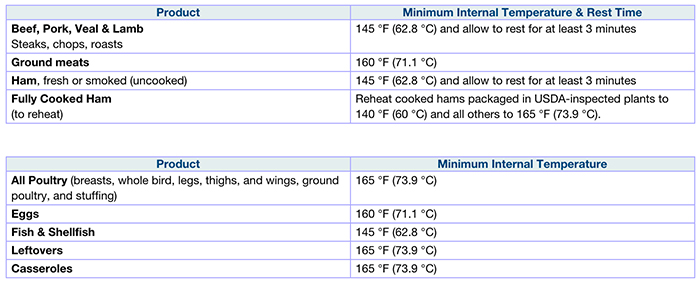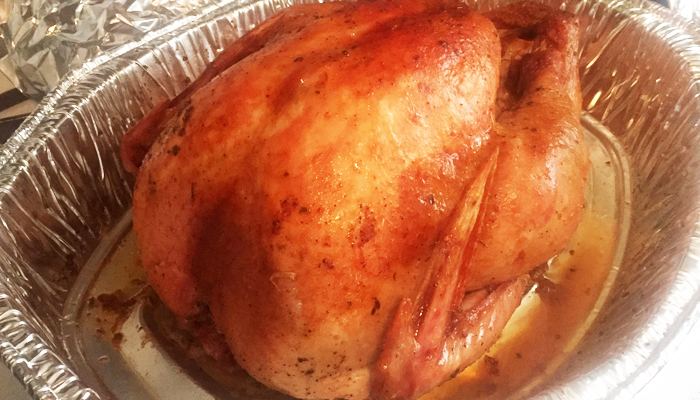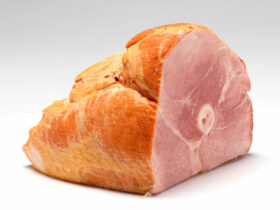To stuff or not to stuff your bird that is the question. It may be a tradition in many households, and it can be done, but it must be done in such a way that the stuffing reaches an internal temperature of 165° F (73.8 C).
The raw juices from the bird will of course drain into the stuffing in the cavity. Stuffing, or as some of us call it dressing, packed dense in the cavity may not reach an internal temperature high enough to kill bacteria, particularly salmonella. To get stuffing inside the bird to the proper temperature would mean you would have to overcook the turkey (Zimmer, n.d.).
One option is to stuff the bird, after it has been cooked, with stuffing that had been cooked separately and to the proper temperature. Maybe your turkey is stuffed for the visual effect at the table, so doing it this way ensures all foods have been cooked properly, and you still can present a stuffed turkey at the dinner table for the traditional carving.
Some of you, of course, stuff a turkey to take advantage of the meat flavor. An option however, is to cook down the neck bone, gizzard, and liver/heart to create a broth for your stuffing. Once cooked down strain off the broth. While the broth is working sweat some celery and onions in a sauté pan. Add poultry seasoning and/or fresh or dried sage to the broth. Your stuffing will taste wonderful and will have the flavor of the turkey that many of us strive for with our stuffing.
Below you will find a chart that has recommended internal cooking temperatures. To check the internal temperatures you will need a food thermometer that can be picked up at any Wal-Mart or other retailers that has a house wares section. The temperatures listed are the minimum required to kill bacteria, this does not mean however, that you cannot cook to a higher temperature if you so desire.

Last Modified Jan 15, 2015: Graph courtesy of USDA, 2015.
The CDC estimates that each year roughly 1 in 6 Americans (or 48 million people) get sick, 128,000 are hospitalized, and 3,000 die of food borne diseases (CDC, 2014).
This is a significant number of people. Keep in mind the numbers are based on the ones that report they are sick, so how many just tough it out and do not bother seeking medical help. Some of you may know of someone that has or you may have yourself experienced nausea, vomiting, or other symptoms after eating a meal.
The upset stomach may be caused by bacteria that were not destroyed during the cooking process, or the ones handling your food did not wash their hands properly or properly sanitize the food preparation areas.
Proper handling of raw foods is important to keep you and your family safe. Cutting up raw poultry on the counter and then not properly sanitizing the work area can cause cross contamination. If you used a cutting board, for example, to cut up poultry, and then only rinsed it off before cutting up lettuce or bread means any bacteria present will get into the bread or lettuce, which would not likely be cooked, so there would be no way of destroying the bacteria.
Putting raw meats in the refrigerator can cross contaminate other foods if the meat drips from an upper shelf onto foods that may not be cooked. Put meats in a pan so the juices are collected and put all raw meats on the lowest shelf.
Wash all surfaces with bleach and water solution and clean all cutting boards with the same solution and rinse well after letting the solution set.
Recommendations for cleaning food handling equipment and food contact surfaces such as stainless cutlery, plastic cutting boards and countertops, is to use a 1/4 cup of Clorox® Regular-Bleach per gallon of water. Allow at least two minutes of contact time before rinsing. You can let countertops air dry. Clean any food particle off the surfaces using soap and water before using the bleach solution.
Wooden cutting boards are hard to disinfect, because of their porous nature, so they probably should not be used to process raw meats.
A previous article talked about produce and how it can contain bacteria that can sicken you. It is surprising with all of the inspections, regulations, and standards for processing plants that any food product is contaminated at all, but fresh foods like produce have been and will continue to be contaminated. Okay, so we all know this, so what do you do?
Produce is of course a raw product, and much of it is eaten raw, in other words, there is not usually a cooking process with high enough temperatures to destroy bacteria such as E. coli.
The fertilizer used for organically grown products is organic fertilizer usually animal manure. Manure and dirt can easily get on the produce, as well as, other contaminates being transferred from those that handle the product on its way to the local grocery store. It may very well arrive at your local supermarket contaminated.
Wash your produce even thick skinned produce with diluted white vinegar, or soapy cool water or at the very least wash and scrub with clean water. Rinse well with clean water after using soap. Scrubbing vegetables with thick skins using a soft brush is recommended as well.
CDC. (2014). Retrieved 2015, from http://www.cdc.gov/foodborneburden/
USDA. (2015). Retrieved 2015, from http://www.fsis.usda.gov/wps/portal/fsis/topics/food-safety-education/get-answers/food-safety-fact-sheets/safe-food-handling/safe-minimum-internal-temperature-chart/CT_Index
Zimmer, E. (n.d.). Retrieved 2015, from http://www.seriouseats.com/2009/11/alton-brown-says-no-to-stuffing-the-turkey-dressing-thanksgiving.html
Source link: https://prepforshtf.com/lets-talk-turkey-cooking-guidelines-to-stay-safe/ by at prepforshtf.com











